by Jochen Szangolies
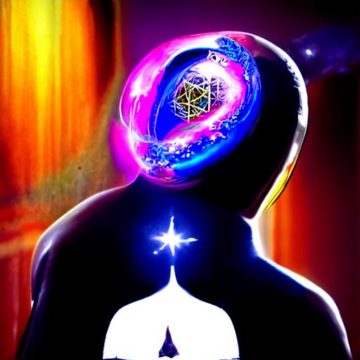
Reading the words ‘mind’ and ‘quantum’ in close proximity on the internet rarely inspires great confidence. Indeed, all too often, all this indicates is that you’re about a click away from learning about life-changing techniques of ‘Quantum Jumping’ to a parallel reality where all your wishes come true, using ‘Quantum Healing’ to ‘holistically’ heal the ‘bodymind’, and other What the Bleep Do We Know!?-esque nonsense. Therefore, in writing about the fraught intersection of quantum mechanics and the study of consciousness, one is faced first with the challenge of convincing the reader that there is actually something of value to be gained from investing their attentional resources. So let me first consider arguments against the relevance of quantum mechanics for consciousness.
First, of course, mere woo-by-association does not make a good argument. That people have misused the buzzwords of ‘quantum’, ‘mind’, ‘consciousness’ and the like to promote shoddy self-help strategies does not entail that they can’t be combined in a sensible, and ideally even illuminating, way. But there are commonly-cited objections that deserve serious consideration.
The most common is the ‘large, warm, and wet’-argument. Quantum mechanics is often (if somewhat misleadingly) considered to be the ‘science of the small’, whose effects are typically observed at length scales far removed from everyday sizes, and thus, from brains. Furthermore, quantum effects typically requires systems to be well-isolated from the environment, to not fall prey to decoherence effects. But brains aren’t generally thus isolated—indeed, in a sense, it’s the very point of a brain to interact with the environment. Finally, quantum systems, to limit interaction, often have to be cooled down to a few degrees above absolute zero, something that again isn’t conducive to the proper functioning of a brain.
On this basis, physicist Max Tegmark has estimated that coherence times in the human brain are on the order of 10-20 – 10-13 seconds, while the relevant dynamical brain processes take place on the millisecond scale—at least ten billion times slower. While more recent developments in quantum biology, such as the possible role of quantum effects in the magnetoreceptive sense birds use to navigate according to Earth’s magnetic field, have opened up the window for a relevance of quantum effects in biology, that’s still a large gap to close.
But this argument misses another, perhaps more intriguing, possibility. It is easily extended to other elements of our daily lives: your computer, say, or the desk it sits on. Consequently, quantum mechanics shouldn’t play any role in the functioning of either—should, indeed, have no explanatory relevance for the everyday world. But nothing could be further from the truth.
The Quantum in the Quotidian
Let’s start with your computer. It’s about as large and as warm as your brain (but hopefully less wet). Yet, the functioning of many modern electronic components rests on intrinsically quantum effects. Even though it’s (to the best of my knowledge) not used in modern-day desktop computers, take as an example the tunnel diode, used as a high-frequency switch: as its name implies, it makes use of the quintessentially quantum tunnel effect, where particles may ‘tunnel’ through an energy barrier they could classically never overcome. So, even macroscopic devices may, for their functioning, rely on quantum phenomena.
In contrast, there is no intrinsically quantum effect at work regarding the desk the computer is so securely placed upon. But how does that, actually, work? What is it that prevents it from simply heeding gravity’s siren song, following it to the depths below, perhaps even sinking down to Earth’s very core? Certainly, you’ve heard the old canard that ‘matter is mostly empty space’, so why don’t those billowy wisps of orbiting electrons just pass right through one another?
Well, for one, of course, electrons, being equal charges, repel one another. Large chunks of matter may be electrically neutral overall, negative electron shells balanced out by positive protons in atomic nuclei, but at small enough scales, atoms’ electron shells repulse one another. But there’s another effect here that’s responsible for the extension of those shells themselves, and for the fact that matter can’t be infinitely compressed: the so-called Pauli exclusion principle, which states that no two particles of a certain type (fermions, which are characterized by the fact that the property known as ‘spin’ can only assume half-integer values) can ever be in exactly the same state. Thus, thinking about the different states available for particles in a given configuration as little ‘boxes’, in the case of electrons, you get two particles per box (which differ from each other in their spin’s orientation), and that’s it, forcing you to fill box after box as more electrons are added.

Contrast that with the behavior of light: photons, not being subject to Pauli exclusion (they are bosons with whole-integer spin), readily bunch up together, so there are no configurations of ‘extended light’ (instead, you get lasers). Thus, ordinary matter owes one of its most important properties, its very extendedness—so important that Descartes took it to be its defining characteristic, christening ordinary matter res extensa (‘extended stuff’)—to quantum mechanics.
Quantum mechanics may be explanatorily relevant even in the absence of overt quantum effects. The question ought then to be permitted—can quantum mechanics do for Cartesian res cogitans (‘thinking stuff’) what it has achieved for res extensa: furnish an explanation of its characteristic nature?
So, far from an ‘out-there’ notion, the application of quantum mechanics to the study of the mind, in the light of the above considerations, seems a rather natural avenue of inquiry. Indeed, there is a certain tension in the received attitude to this question. Most physicists, I believe, would subscribe to a broadly materialist thesis regarding the mind, that is:
(T1) The properties of the mind are determined solely by the properties of matter.
Furthermore, the general expectation regarding the properties of matter, in turn, is a certain kind of reductionism:
(T2) The properties of matter are ultimately determined by quantum physics.
Yet, a still widespread belief is that:
(T3) Quantum physics has nothing to offer as regards the explanation of mental properties.
Now, T1-T3 aren’t in direct contradiction: it might be the case that only ‘classical’ material properties are needed to explain the mind, and thus, quantum mechanics has nothing over and above perhaps the explanation of these properties to add. A computationalist, who believes that mind is nothing but a computation carried out by the brain (in whatever form this thesis is exactly explicated), would subscribe to such a view: quantum computers, while able to perform certain tasks significantly faster than their classical counterparts, cannot perform any essentially new tasks. So unless the explanation of the mind rests on the ability of quickly factoring large numbers, quantum mechanics has nothing essentially new to add here.
But there is enough of a tension in these theses that one might explore possible avenues for how quantum mechanics could be important to the explanation of the mind. What essential novelty does it bring to the table that, as in the case of the extension of matter, could open up a fresh road of inquiry into the mind-body problem?
Mind and Matter: A Brief Taxonomy
Most quantum-approaches to the mind are concerned with the relevance of quantum effects for the functioning of the brain. These are analogous to how the functioning of certain components of your computer can only be explained in quantum mechanical terms. Examples of this include the proposal that ‘neural qubits’ could be protected from decoherence by special molecular configurations, due to University of California physicist Matthew Fisher, or the more well-known ‘Orch-OR’ (short for ‘Orchestrated Objective Reduction’) model due to Nobel laureate Roger Penrose and University of Arizona anesthesiologist Stuart Hameroff. (Although strictly speaking, the latter isn’t a ‘quantum’ model in the sense that it invokes an objective collapse of the wave function, aimed at giving the mind abilities exceeding that of classical—and quantum—computers, which makes it a ‘post-quantum’ theory.)
But the analogy to the explanation of Cartesian res extensa in quantum terms opens up another, potentially more radical, option of investigating the conceptual innovations of quantum theory and their potential for the explanation of consciousness. Therefore, let’s take a look at the situation before the advent of quantum mechanics. A philosopher working on the problem of the interrelationship of mind and body might strive to set up a map of the possibilities, simply by considering possible ways for two apparently distinct sets of phenomena to interrelate. This, it seems, is nothing but an exercise in combinatorics: listing and characterizing all a priori available options.
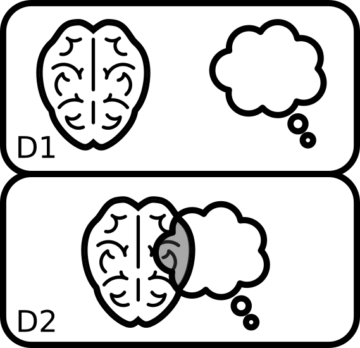
The first option is that each domain stands on its own, with no relation between them: the thesis of dualism (D1). This raises the obvious question: if mind and matter are essentially separate, how do we know about the material world, react to it, interact with it, at all? One possible answer would be to appeal to a hypothesis proposed by 17th century philosopher and co-inventor of calculus Gottfried Wilhelm Leibniz, namely, the notion of ‘pre-established harmony’: every substance affects only itself, but in such a way (carefully ‘programmed’ in advance by some divine agency) as to appear to interact with one another. However, on this notion, it’s not clear why one substance actually would need the other: removing it would make no appreciable difference.
Another possibility, and the next logical option, would be to allow for some ‘overlap’ between the mental and the material, leading to a kind of interactionism or interactionist dualism (D2). This was the option favored by Descartes himself, who famously, and somewhat inexplicably, identified the pineal gland as the locus of ‘overlap’ between the mind and the brain. On this, he was immediately skewered by Elisabeth, Princess of Bohemia, who pointed out the difficulty in how an immaterial substance could act on a material one, eliciting little but evasion from Descartes.
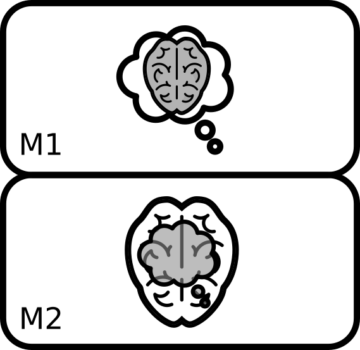
However, with the possibility of overlap on the table, there arrives the option of making it total: that is, of having one set of phenomena wholly contained within the other. These are the monist approaches, differing only in which substance is taken as fundamental, or to ‘really exist’—the mental, yielding idealism (M1), or the physical, leading to materialism (M2). Both approaches have found skillful defenders and been met with violent opposition alike, from Dr Johnson kicking stones in response to Bishop Berkeley’s immaterialism to La Mettrie being chased out of France for proclaiming humans, like animals, to be mere machines.
Having thus outlined the possible interrelationships between the two domains, our pre-quantum philosopher might have the realization that
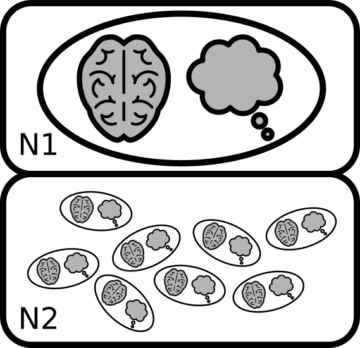
the answer to the question of what among mind and matter is more fundamental might just as well be ‘neither’—i. e. that that there might be a third kind of substance, a ‘neutral’ common ground to both mind and matter alike. For instance, both mind and matter could reduce to a third kind of thing, which gives rise to either, say, in appropriate configurations, the way water molecules give rise to ice and steam alike. This is the thesis of neutral monism (N1). Or, every fundamental phenomenon could have both a mental and a material aspect, or ‘pole’, leading to dual-aspect monism (N2). (Note that N1 and N2 are sometimes not sharply distinguished from one another, or from panpsychism, the view that every phenomenon has a mental aspect.)
This latter cluster of views has received a boost of popularity in modern times. While dual-aspect theory can be traced back at least to the 17th century, where Baruch de Spinoza considered God (or Nature, Deus sive Natura) to have the aspects of extension and mind, many of its most intricate expositions emerge fairly recently, such as with David Chalmers, who considers a dual-aspect view of information. Neutral monism is most prominently associated with the great American pragmatist philosopher and psychologist William James, the physicist Arthur Eddington, and logician and philosopher Bertrand Russell.
Having thus exhausted the possibilities, our hypothetical philosopher might busy themself eliminating one after the other, until, hopefully, just one remains, which then must be the true characterization of the relationship between mind and matter.
Quantum Complementarity
But what if they find that there are decisive objections to every option on the table? They seem to run the gamut of what is logically possible regarding the mind-matter relation. What are we left with, if they are all crossed out?
I believe the answer is that we have been premature in asserting that these are all the options on the table. Quantum mechanics has shown us, more forcefully than perhaps any other scientific discovery, that the world is not limited by what we might consider sensible. And on this issue, too, it has shown us a way between and beyond the options we had naively enumerated: this is the notion of quantum complementarity.
Complementarity sometimes gets short shrift as compared to more flashy quantum ‘paradoxes’ like entanglement, tunneling, or dead-and-alive cats. But I think it is ultimately far more radical in its implications: it shows us that there are situations where, to encompass them fully, we have to resort to distinct modes of description that can neither be unified nor reduced to one another, yet are each indispensable.
The classical example is the behavior of light, which must be described appealing to both wave- and particle-like descriptions. Whenever we observe a photon, it appears as a tiny dot on a photographic plate; yet light can produce interference effects, like waves. Furthermore, when we observe light, bringing its particle-like character to the fore, suddenly, interference effects vanish. We can only ever elicit one aspect of its dual nature at any given time (in any given context), but can never entirely excise the other.
The notion of complementarity was introduced by Danish physicist Niels Bohr, who considered it perhaps the central phenomenon of quantum mechanics. He thought that its clearest expression is found in the famous uncertainty relation due to Werner Heisenberg, who formulated the first full theory of quantum mechanics. The uncertainty principle tells us that for certain pairs of quantities, information you have about one of them puts a bound on the information that can be acquired about the other—the classical example being position and momentum (velocity). This ties directly into the wave-particle picture of complementarity, as particles are nothing but states of perfectly definite position, while waves, spread out infinitely over space, possess perfectly definite momentum.
Complementary quantities then break out of the classification proposed above: they can neither be thought of as separate, nor as reducible to one another, nor as expressions of some third kind of thing. They are each parts of the full picture, but there is no ‘full picture’ available—they constitute jointly the maximum of what can be said about the phenomena. That means that the picture of ‘sets’ of phenomena underlying the above classification is inapplicable: complementarity provides an entirely new way for classifying the relation between phenomena.
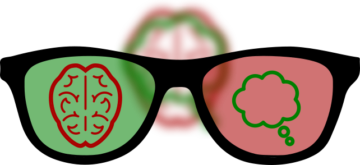
The idea of using this relation, initially supposed to apply to quantum properties of systems, in a wider context is not new. Bohr himself has proposed extending the principle beyond physics. Influenced by the vitalism of his father, Christian Bohr, he proposed that a full understanding of the phenomenon of life is only possible by means of the complementarity between physical causality and biological purpose. In psychology, he noted a complementary relationship between feelings and rational thought about those feelings. (For some more on the principle of complementarity and its application beyond physics, see this insightful article by Ashutosh Jogalekar.)
But it was Wolfgang Pauli—he whose principle already accounts for the extended nature of matter—who first, under the influence of ideas from psychoanalyst Carl Jung, proposed that mind and matter themselves could stand in a complementary relationship. As he puts it in a letter to Rosenfeld in 1952 (translation by Harald Atmanspacher):
The general problem of the relation between psyche and physis, between inside and outside, can hardly be regarded as solved by the term ‘psychophysical parallelism’ advanced in the last century. Yet, perhaps, modern science has brought us closer to a more satisfying conception of this relationship, as it has established the notion of complementarity within physics. It would be most satisfactory if physis and psyche could be conceived as complementary aspects of the same reality.
What this view points to, then, is a reality that cannot be exhaustively described in either mental or physical terms, or even by the conjunction of both, but that it only appears to us in a given context as either material or mental. In the present day, this suggestion is pursued, mainly, by the German physicist Harald Atmanspacher and collaborators. They consider this idea a version of dual-aspect theory, and in a sense, that’s justifiable; however, I believe that there is a useful distinction here to ‘classical’ dual-aspect monism, in that the dual aspects are not just static properties of some underlying, perhaps unknowable fundamental reality, but are in their presentation themselves a function of the mode of inquiry or description applied to ‘fundamental reality’. The photon does not statically have a wave-nature and (or?) a particle-nature, but presents wave- and particle-like aspects in appropriate experimental setups. Likewise, on such a ‘complementarity monism’, the world is not simply physical and mental in character, but exhibits appropriate characteristics in different circumstances.
Viewed in this light, then, the notion of complementarity provides a possible new angle on the question of the relation between mind and matter, that has the potential of providing new answers to the problems faced by the traditional approaches.
